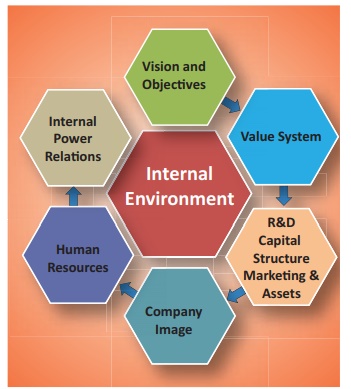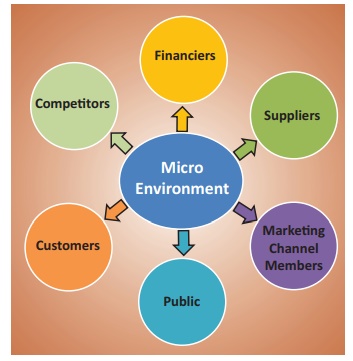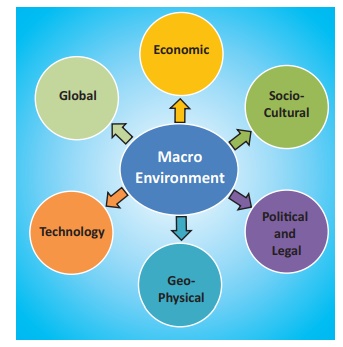Chapter: 12th Commerce : Chapter 19 : Business Environment : Environmental Factors
Types of Business Environment
Types of Business Environment
The Business Environment can be classified as
follows:

I) Internal Environment
II) External Environment
Internal environment refers to those factors within an
organisation e.g Policies and programmes, organisational structure, employees,
financial and physical resources. These factors can be changed or altered and
hence are known as controllable factors.
External environment refers to those factors outside the business These
factors by and large are beyond the control of a business and hence
uncontrollable .e.g economic, political and socio-cultural factors.
1. Internal Environment
Internal Environment Factors

The major internal factors affecting business
decisions are
i. Values system: The
values of the founder/ owner of the business , percolates
down to the entire organisation and has a profound effect on the organisation.
The success of an organisation depends upon the sharing of value system by all
members. External business associates like suppliers and distributors consider
the value system practised by an organisation with strong culture of ethical
standards and values.
ii. Vision and objectives: The
vision and objectives of a business guides its operations and strategic
decisions. Example ‘Amul the taste of India’ Gujarat Co-operative Milk
Marketing Federation GCMMF
Two Indian companies TATA Steel and
WIPRO have been named as the world’s most ethical companies by American Think
tank Ethisphere Institute. Infosys, Murugappa group, TVS group
Vision: Liberate our farmers from economic
oppression and lead them to prosperity.
iii. Management structure and ature: The structure
of management/board and their style of functioning, the level of
professionalism of management, the composition of the board are the various
factors which affects the decision making. Since the board is the highest
decision making authority, it’s composition, degree of professionalism and
style of operations plays a very critical role in the growth and development in
an organisation.
iv. Internal power relations: This
refers to the internal power relations that exist in an organisation. The
relations among board members , between board members and the CEO and the level
of support enjoyed by the board from its’ stakeholders namely employees and
shareholders are significant factors which affects decision making and its
implementation in an organisation.
v. Human
resources : The success of an enterprise is solely dependent on its manpower. Therefore the
quality, skill competency, right attitude and commitment of its human resources
is essential for the success of an organisation.
vi. Company image: The image
of an
organisation plays an important role in introducing new products,
selecting agents and dealers for distribution, forging alliances with
suppliers, expanding and entering new markets both domestic and international,
raising finance etc.
vii. Other factors: The
firm’s ability to innovate reflected by its research and
development, the strength of its financial position and the capital structure,
the efficiency in managing the marketing and distribution network ,and the
physical resources like plant, building technology are the other major factors
on which affects the success of a business.
2. External environment
All factors outside the business which have a
bearing on the working of a business can be termed as the external environment.
This is subdivided into micro or task environment and macro or general
environment.
3. Micro Environment
Micro
Environment Factors

This refers to those factors which are in the
immediate environment of a business affecting its performance. These include
the following:
i) Financiers:
The
financiers of a business which
includes the debenture holders and financial institutions play a significant
part in the running of a business. Their financial capability, policies
strategies, attitude towards risk and ability to give non–financial assistance
are all important to a business.
ii) Suppliers:
In any
organisation the suppliers of raw
materials and other inputs play a very vital role. Timely procurement of
materials from suppliers enables continuity in production and reduces the cost
of maintaining stock/inventory. Organisations generally obtain supplies from a
panel of suppliers instead of relying on a single source. Organisations have
realised the importance of nurturing and maintaining good relationship with the
suppliers.
iii) Marketing
Channel members: The marketing
inter-mediaries serve as a connecting link between the business and its
customers .The middlemen like dealers, wholesalers and retailers ensure
transfer of product to customers .physical distribution is facilitated by
transporters, and warehouses help in storing goods. Market research agencies
help the firm to understand the needs of the customers while advertising
agencies help in promoting the products and services. Insurance firm is another
marketing intermediary which provides coverage for risk in business.
iv) Public
This
refers to any group like media group,
citizen action group and local public which has an impact on the business. The
public group has the ability to make or mar a business. Many companies had to
face closure due to actions by local public.
v) Customers:
The aim
of any business is to satisfy the
needs of its customers. The customer is the king and the fulcrum around which
the business revolves. Hence it is essential for any business to understand the
needs of its varied customers like individuals,
retailers, wholesalers, industries and government sector. Customer relationship
management aims at creating and sustaining cordial relations with customers.
vi) Competitors:
All
organisations face competition at
all levels local, national and global. Competitors may be for the same product
or for similar products. It is important for a business to understand its
competitors and modify their business strategies in the face of competition.
For example. the closure of Sterlite
Copper factory in Thoothukudi due to protests by environment protection group
in 2018.
4. Macro Environment:
Macro
Environment Factors

This is the general or overall environment in which
the business operates. The success of a business is dependent on its ability to
adapt to the macro environment, since these are uncontrollable factors. They
offer enormous opportunities to business and also poses serious threats to
business. The general or remote environment factors are as follows;
I. Economic environment: The business is an integral part of
the economic system prevalent in a nation. The multiple variables in the macro
environment system which has a bearing on a business include
1) The
nature of economy based on the stage of development: The
countries across the globe can be
categorised on the basis of growth and per capita income as developed nations,
developing nations and under developed nations. The USA, Japan, Germany, Canada
and Australia developed economies generally have high degree of technological
advancement, very strong and robust industrial base, and high standard of
living. Many of these developed nations have successfully integrated the
computer based technologies with their existing business. Developing nations
like India, China, Brazil Mexico are middle income economies are characterised
by low to moderate industrial growth, the inequality in the distribution of
income, high population, a low standard of living and slow absorption of
technology. Under developed nations are low income economies with a very low
degree of technology adoption and a very poor standard of living.
2) The
nature of economic system: The economic
systems can be classified as Capitalistic, Socialistic and Mixed economy.
Capitalistic economy is a free enterprise market where individual ownership of
wealth is predominant. Socialistic economy is a state controlled with a lot of
restrictions on private sector. Mixed economy is a combination of both state
owned and private sector ownership.
3) The
economic policies of a nation: Monetary policy, fiscal policy,
Export-import policy, Industrial policy Trade policy, Foreign exchange policy
etc are part of the economic environment.
4) Economic
indices: The Economic indices like
GDP, GNP national income, per-capita income, balance of payments, rate of
savings and investments etc. form an important part of economic environment.
5) Development
of financial market: The organisation
and development of money market, capital market securities market and, the
banking system has a greater impact.
6) Economic
structure: The Economic
structure includes capital formation, investment pattern, composition of
trade balance, occupational distribution of workforce, and the structure of
national output.
II. Socio-Cultural environment - Business is a part of the society .Social environment
refers to the sum total of factors of the society in which the business is
located. Social and cultural environment of society affects the business. It is
dynamic and includes the behaviour of individuals, the role and importance of family,
customs, traditions, beliefs and values, religion and languages, the ethical
values. The literacy level, and the social attitudes of the people of the
society. The socio-cultural environment also includes the following;
1) The social institutions and groups
2) Family structure prevalent in the society
3) Role of marriage as an institution
4) Caste system in the society
5) Customs , beliefs and values
6) Demographic factors which includes the size,
composition, literacy level, distribution and mobility of the population
7) The lifestyle of people and their tastes, likes
and preferences.
III. Political and Legal environment – The framework for running a business is
given by the political and legal environment. The success of a business lies in
its ability to adapt and sustain to political and legal changes. The
legislative, executive and judiciary are the three political institutions which
directs and influences a business.The major elements of the legal and political
environment are
1) Political stability is reflected by the
following parameters like the election system, the law and order situation, the
role and structure of Military and Police force, the declaration of President’s
rule, civil war etc
2) Political organisation refers to the ideology and
philosophy of the political parties, the government, the role and degree of
authority of bureaucracy, the level of political consciousness among citizens
and the funding of political parties by business houses and the clout wielded
by them.
3) The image of the leader and the country in the
inter-national arena.
4) Legal framework of business and their degree of
flexibility.
5) The constitution of the nation.
6) The Foreign policy of the country with special
reference to tariffs and free trade.
IV. Geo-physical environment – The natural, geographical and ecological factors
have a bearing on the business. These are as follows;
1) the availability of natural resources like
minerals oil .etc, since setting up of industries requires availability of raw
materials
2) the weather and climatic conditions and
availability of water and other natural resources is essential for the
agricultural sector .
3) topographical factors like the terrain impacts
type of business since the demand and consumption pattern may vary in these
regions. E.g in the the hilly region mode of transport will have to be modified
to tackle the terrain.
4) ecological factors are now gaining momentum,
since the governments across the globe are framing stringent policies for
ecological conservation and prevention of pollution. The ban on use of plastic
bags imposed by the Ooty corporation is an example.
5) location of certain industries is influenced by
the geographical conditions For e.g In Tamilnadu the concentration of cotton
textile industry in Coimbatore is due to conducive weather conditions. .
6) availability of natural harbours and port
facilities for transporting goods .
V. Technological environment
The development
in the IT and telecommunications has created a global market. Technology is widely
used in conducting market research for understanding the special needs of the
customer. Digital and social media are used as a platform for advertising and
promoting the products/services. Data-mining and data analytics are used to
know the customer better. Technology is used in managing inventory, storing
goods in warehouses, in distributing goods and in receiving payment. This
dynamic environment also includes the following ;
1) the
level of technology available within the country
2) rate
of change in technology
3) technology
adopted by competitors
4) technological
obsolescence
VI. Global environment
With the rapid growth of technology the
physical boundaries are fast disappearing and the new global market is
emerging. The international environmental factors which affects a business are
as follows;
1) Differences in language and culture
2) Differences in currencies
3) Differences in norms and practices
4) Differences in tastes and preferences of people
5) The tax structure relating to import and export.
6) Differences in the degree of adoption of
technology.
Related Topics